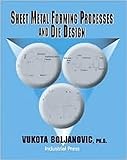Manufacturing Processes - Sheet Metal Forming Process
Sheet Metal Forming Process

Sheet Metal Forming
The sheet metal forming process comes under the category of forming as a manufacturing process. There are a number of sheet metal forming methods available which all consist of some form of deformation of the material. The main sheet metal forming methods are:
- Blanking, where a shaped piece of metal is sheared from a continuous strip.
- Stretching, where a sheet is gripped at its edges and a form block is pushed in to the sheet to deform it. The material must pass beyond its material yield point to take a permanent deformation but it should be understood that there will always be a certain amount of spring back once the load is removed.
- Bending, this is where a sheet is bent over a shaped tool usually using a folding machine or press brake. The most common bend form is the 'L' shape and other options are the 'V' and 'U' shape bending tools. Again care needs to be taken to ensure the amount of spring back of the material is taken into account when bending to achieve the required angle of bend and steps should be taken to ensure there is no thinning of material through the bend.
- Drawing, this is where the sheet metal is formed between a tool and a die. The edge of the material is suitably clamped and a punch is pushed into the material forcing it into the die. Normal practice is to support the underside of a sheet with a pressure pad which helps alleviate any potential tearing problems. The criteria for deep drawing is defined as a depth to diameter ratio of equal to or greater than 1:1
- Pressing, this process can be considered to be a combination of bending, stretching and drawing. There are 2 side of a mould pushed together with the sheet metal in between to form the required shape. Sometime the bottom mould can be a rubber compound that simply forces the sheet metal around the form of the upper mould, this is useful for small batch production quantities.
Machines and dies can be quite costly but the quality of the product depends on the die design and lubrication used. A better finished die produces a higher quality component.
The main problems associated with sheet metal forming are the aforementioned springback issues, which can be resolved through calculation or, for small batch with general tooling, trial and correction.
Sheet metal forming processes are often accompanied with heat treatment stages, this is particularly true of aluminium alloys which are often annealed then solution treated for final forming and precipitation hardened after final processing. Placing an aluminium alloy component in a freezer at around -19C will delay the period of hardening after solution treatment to keep the material in a soft state for longer.
Sheet Metal Shearing and Bending
Machinery HandBook 28th Edition

Manufacturing Processes - Additional Resources
- Manufacturing Processes and Methods Process
The selection of a manufacturing process is done very much on the basis of a manufacturer choosing the process that best suits his needs. Consideration must be given to a number of factors before deciding on a... - Materials Selection versus Manufacturing Process
Material selections can determine what manufacturing processes are available, form can determine what materials can be used and manufacturing processes can determine what form can be created. So what you... - Manufacturing Processes - Isostatic Pressing
Isostatic pressing is a powder processing process that falls in the category of forming under the general category of manufacturing processes. There are 2 types of isostatic pressing processes: Hot... - Manufacturing Processes - Pressing and Sintering
Pressing and sintering is a powder processing process that falls in the general category of forming under the manufacturing processes umbrella.The powder is pressed in closed dies to form a green compact that... - Manufacturing Processes - Vacuum Forming
The vacuum forming process comes under the general manufacturing processes category of forming. The process involves producing components that are formed by heat softening plastic sheet and forcing it against... - Manufacturing Processes - Blow Moulding
The blow moulding process fits in the general manufacturing processes category of 'forming'. A heat softened hollow plastic blank, sometimes referred to as a 'parison' is clamped between two mould halves. Air... - Manufacturing Processes - Forging
The metal forging process comes under the category of forming as a manufacturing process. It involves the forming or shaping of bulk metal between dies which mirror the shape of the component or section of a... - Manfacturing Processes - Rolling And Metal Forming
Metal rolling is manufacturing process that falls under the general category of forming. It facilitates the continuous forming of bulk metal between two rotating roller tools. It is a 2 dimensional process... - Manufacturing Processes - Extrusion Process
Extrusion fits under the general category of forming in manufacturing processes. The term applies to a variety of processes that involve confining a material in a container and applying a force to push the... - Manufacturing Processes - Superplastic Forming
Superplastic forming as the name suggests falls in the manufacturing processes category of forming. The process works under closely controlled conditions of temperature and strain rates which allow certain... - Manufacturing & Technology Blog
Manufacturing and industrial information on manufacturing processes, project management, engineering principles and technology. - Statistical Process Control versus Acceptance Sampling
There are two types of product quality control approaches that are going to be compared and contrasted in this article, namely: Acceptance Sampling Statistical Process Control. (SPC) The purpose of...








